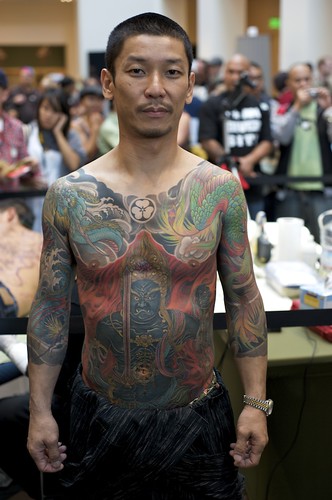


Japanese tattoos have long been associated with the Yakuza, but Japanese tattoo traditions go way beyond criminality. Like many other world cultures the Japanese had a traditional and distinctive version of tattoo art.
The History of Japanese Tattoos
The history of Japanese tattoos goes back to 10,000 BCE. The woman of the Ainu people used tattoos to make themselves look like their goddess, so that demons (who caused diseases) would mistake them for the goddess and get scared. These tribal tattoos started at an early age with a small tattoo on the upper lip. When growing older this small tattoo was expanded.
From 300 BC to 300 AD tattoos were used for spiritual and social purposes. Just like in other tattoo cultures, they were an indicator of ones social status.
From 300 AD on, tattoos were used in Japan to mark criminals. This practice is called bokukei or bokkei. Japan was the last country to stop marking criminals with tattoos (in 1870). People started covering up these marks of shame with more decorative tattoos and that's how the art started.

Japanese Tattoo Art (1870)
Tattooing in Japan reached its zenith in the 1800s, during the Edo period, a time when the power and influence of the common people was very much on the rise. One way in which people chose to use their new-found wealth was to celebrate their art and culture with tattoos. The beauty of the images created was considered a reward for enduring what was, at the time, a long and painful process.
Around 1870 the Japanese government outlawed tattoos in order to make a good impression on the Western world. As a result, Japanese tattoos went underground and became affiliated with the Yakuza, the Japanese mafia.

Tattooing in Japan was legalized again in 1945 by the occupying forces, but never really lost its association with crime. Even today people with tattoos are still banned from businesses like fitness centers, in an attempt to restrict the yakuza from entering their place.
Tattoos in Modern Japan
Nowadays tattoos are gaining popularity amongst the Japanese youth. They are not primarily interested in traditional irezumi though, they prefer the American style of tattooing and tribals. They are more interested in one-point tattoos, smaller tattoos on one part of the body that are usually done in one sitting.
The Western style of tattoos (which they call yobori, as opposed to wabori) is popular in Japan, especially the old school style like heart, skull and rose tattoos. Tattooing in Japan is also getting more attention among females than among males, something that used to be the opposite. They have become a fashion object.
Although tattoos are getting more popular in Japan, they still face resistance by the Japanese cultural code. That's why temporary tattoos enjoy a wider popularity than permanent tattoos over there.
Horimono or Irezumi

Japanese art
- Horimono: the Japanese word for "carving".
- Irezumi: means "insert ink".
Both words refer to the art of tattooing.
Japanese tattoo art was an offshoot of the distinctive woodblock prints, called ukiyo-e. Some of the wood carvers turned to tattooing as an adjunct to their artistic careers, others exchanged their carving-blades for tattoo needles full time as tattooing grew more popular in the 19th century. One of the most famous Japanese tattoo artists of that time, was Horiuno.
Irezumi has got its share of supporters in the West. Some travel to Japan to be tattooed by a Horishi in the Tebori way (by hand), a time-intensive, painful and very expensive undertaking. The traditional Japanese tattoo style is very detailed, what makes getting a Japanese tattoo time-consuming and expensive.
Source : http://www.freetattoodesigns.org/japanese-tattoos.html


No comments:
Post a Comment